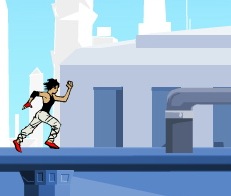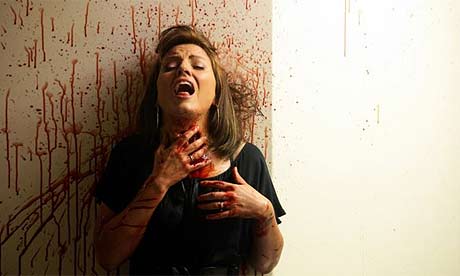Everyone knows the undead don't run - so how come they were sprinting about in Charlie Brooker's recent TV drama? Simon Pegg argues for a return to traditional zombie values
As an avid horror fan, I found the prospect of last week's five-night TV zombie spectacular rather exciting. Admittedly, the trailer for E4's Dead Set made me somewhat uneasy. The sight of newsreader Krishnan Guru-Murthy warning the populace of an impending zombie apocalypse induced a sickening sense of indignation. Only five years previously, Edgar Wright and I had hired Krishnan to do the very same thing in our own zombie opus, Shaun of the Dead. It was a bit like seeing an ex-lover walking down the street pushing a pram. Of course, this was a knee-jerk reaction. It's not as if Edgar and I hadn't already pushed someone else's baby up the cultural high street - but that, to some extent, was the point. In Shaun of the Dead, we lifted the mythology established by George A Romero in his 1968 film Night of the Living Dead and offset it against the conventions of a romantic comedy.
Still, I had to acknowledge Dead Set's impressive credentials. The concept was clever in its simplicity: a full-scale zombie outbreak coincides with a Big Brother eviction night, leaving the Big Brother house as the last refuge for the survivors. Scripted by Charlie Brooker, a writer whose scalpel-sharp incisiveness I have long been a fan of, and featuring talented actors such as Jaime Winstone and the outstanding Kevin Eldon, the show heralded the arrival of genuine homegrown horror, scratching at the fringes of network television. My expectations were high, and I sat down to watch a show that proved smart, inventive and enjoyable, but for one key detail: ZOMBIES DON'T RUN!
I know it is absurd to debate the rules of a reality that does not exist, but this genuinely irks me. You cannot kill a vampire with an MDF stake; werewolves can't fly; zombies do not run. It's a misconception, a bastardisation that diminishes a classic movie monster. The best phantasmagoria uses reality to render the inconceivable conceivable. The speedy zombie seems implausible to me, even within the fantastic realm it inhabits. A biological agent, I'll buy. Some sort of super-virus? Sure, why not. But death? Death is a disability, not a superpower. It's hard to run with a cold, let alone the most debilitating malady of them all.
More significantly, the fast zombie is bereft of poetic subtlety. As monsters from the id, zombies win out over vampires and werewolves when it comes to the title of Most Potent Metaphorical Monster. Where their pointy-toothed cousins are all about sex and bestial savagery, the zombie trumps all by personifying our deepest fear: death. Zombies are our destiny writ large. Slow and steady in their approach, weak, clumsy, often absurd, the zombie relentlessly closes in, unstoppable, intractable.
However (and herein lies the sublime artfulness of the slow zombie), their ineptitude actually makes them avoidable, at least for a while. If you're careful, if you keep your wits about you, you can stave them off, even outstrip them - much as we strive to outstrip death. Drink less, cut out red meat, exercise, practice safe sex; these are our shotguns, our cricket bats, our farmhouses, our shopping malls. However, none of these things fully insulates us from the creeping dread that something so witless, so elemental may yet catch us unawares - the drunk driver, the cancer sleeping in the double helix, the legless ghoul dragging itself through the darkness towards our ankles.
Another thing: speed simplifies the zombie, clarifying the threat and reducing any response to an emotional reflex. It's the difference between someone shouting "Boo!" and hearing the sound of the floorboards creaking in an upstairs room: a quick thrill at the expense of a more profound sense of dread. The absence of rage or aggression in slow zombies makes them oddly sympathetic, a detail that enabled Romero to project depth on to their blankness, to create tragic anti-heroes; his were figures to be pitied, empathised with, even rooted for. The moment they appear angry or petulant, the second they emit furious velociraptor screeches (as opposed to the correct mournful moans of longing), they cease to possess any ambiguity. They are simply mean.
So how did this break with convention come about? The process has unfolded with all the infuriating dramatic irony of an episode of Fawlty Towers. To begin at the beginning, Haitian folklore tells of voodoo shamans, or bokors, who would use digitalis, derived from the foxglove plant, to induce somnambulant trances in individuals who would subsequently appear dead. Weeks later, relatives of the supposedly deceased would witness their lost loved ones in a soporific malaise, working in the fields of wealthy landowners, and assume them to be nzambi (a west African word for "spirit of the dead"). From the combination of nzambi and somnambulist ("sleepwalker") we get the word zombie.
The legend was appropriated by the film industry, and for 20 or 30 years a steady flow of voodoo-based cinema emerged from the Hollywood horror factory. Then a young filmmaker from Pittsburgh by the name of George A Romero changed everything. Romero's fascination with Richard Matheson's novel I Am Legend, the story of a lone survivor struggling in a world overrun by vampires, led him to fixate on an aspect of the story leapfrogged by the author: namely, the process by which humanity is subjugated by the aggressive new species. Romero adopted the Haitian zombie and combined it with notions of cannibalism, as well as the viral communicability characterised by the vampire and werewolf myths, and so created the modern zombie.
After three films spanning three decades, and much imitation from film-makers such as Lucio Fulci and Dan O'Bannon, the credibility of the zombie was dealt a cruel blow by the king of pop. Michael Jackson's Thriller video, directed by John Landis, was entertaining but made it rather difficult for us to take zombies seriously, having witnessed them body-popping. The blushing dead went quiet for a while, until the Japanese video game company Capcom developed the game Resident Evil, which brilliantly captured the spirit of Romero's shambling antagonists (Romero even directed a trailer for the second installment). Slow and steady, the zombie commenced its stumble back into our collective subconscious.
Inspired by the game and a shared love of Romero, Edgar Wright and I decided to create our own black comedy. Meanwhile, Danny Boyle and Alex Garland were developing their own end-of-the-world fable, 28 Days Later, an excellent film misconstrued by the media as a zombie flick. Boyle and Garland never set out to make a zombie film per se. They drew instead on John Wyndham's Day of the Triffids, as well as Matheson and Romero's work, to fashion a new strain of survival horror, featuring a London beset by rabid propagators of a virus known as "rage".
The success of the movie, particularly in the US, was undoubtedly a factor in the loose remake of Romero's Dawn of the Dead in 2004. Zack Snyder's effective but pointless reboot parlayed Boyle's "infected" into the upgraded zombie 2.0, likely at the behest of some cigar-chomping, focus-group-happy movie exec desperate to satisfy the MTV generation's demand for quicker everything - quicker food, quicker downloads, quicker dead people. The zombie was ushered on to the mainstream stage, on the proviso that it sprinted up to the mic. The genre was diminished, and I think it's a shame.
Despite my purist griping, I liked Dead Set a lot. It had solid performances, imaginative direction, good gore and the kind of inventive writing and verbal playfulness we've come to expect from the always brilliant Brooker. As a satire, it took pleasing chunks out of media bumptiousness and, more significantly, the aggressive collectivism demonstrated by the lost souls who waste their Friday nights standing outside the Big Brother house, baying for the blood of those inside. Like Romero, Brooker simply nudges the metaphor to its literal conclusion, and spatters his point across our screens in blood and brains and bits of skull. If he had only eschewed the zeitgeist and embraced the docile, creeping weirdness that has served to embed the zombie so deeply in our grey matter, Dead Set might have been my favourite piece of television ever. As it was, I had to settle for it merely being bloody good.



